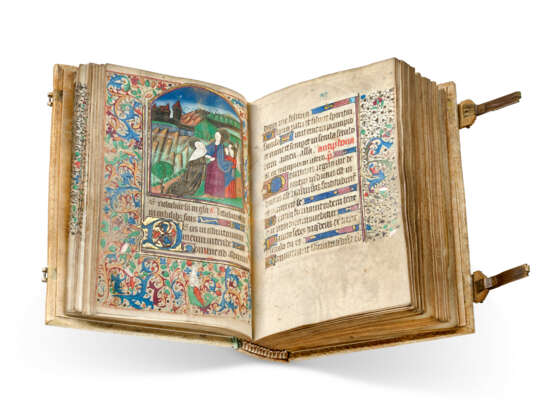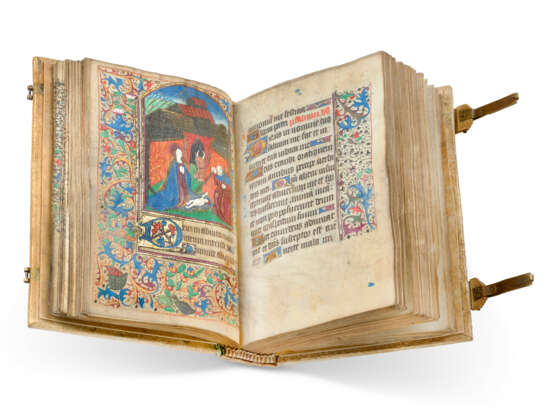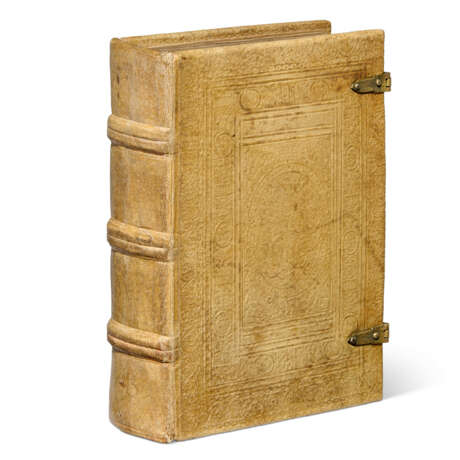ID 1450397
Lot 18 | Master of the Prince of Piedmont
Estimate value
£ 15 000 – 20 000
Book of Hours, use of Lyon, in Latin and French, illuminated manuscript on vellum [Lyon or perhaps Savoy, 1460s]
A Book of Hours painted by the Master of the Prince of Piedmont, an influential figure in the artistic milieu of the Savoyard court whose style extended between Lyon and Geneva in the 1460s.
165 x 110mm. i + 180 + i leaves, collation: 1-26, 3-78, 87 (of 8, lacking vii), 9-128, 139 (of 10, i a cancelled blank), 14-168, 176, 187 (of 8, lacking i), 19-218, 227, 238 (later inserted gathering), 244, some catchwords survive, 15 lines, ruled space: 100 x 50 mm, rubrics in red, small initials and line-fillers in gold and white on red and blue backgrounds throughout, larger initials with floral decorations, 11 large miniatures within full borders of acanthus and ivy-leaf inhabited by fruit, flowers and grotesques, four border miniatures for the Gospel extracts, every page with one-sided acanthus and ivy-leaf borders (lacking two leaves with miniatures after ff.59 and 130, some pigment flaking to the Annunciation miniature, the gold of the initials often a little rubbed, instances of light surface soiling throughout, including to some of the miniature pages, most noticeable on hair sides, occasional losses to page edges). Bound in 16th-century tooled pigskin over wooden boards, ornamental borders and central panels with female figures of Hope and Faith (upper cover) and Charity (lower cover), metal clasps (rebacked, the leather of the upper clasp replaced).
Provenance:
(1) The liturgical use is Lyon, one of the artistic centres in which the Master of the Prince of Piedmont is known to have been active. The calendar includes saints venerated locally, including Clair of Dauphiné (2 January), Baldomerus (28 February) and Epipodius (22 April).
(2) ‘Patricia ?’ added in ink on front endleaf.
(3) A member of the Fenkner family of Goslar, Hanover: ‘Prov. Smlg. Fenkner. Goslar. 1908’ (typed label pasted inside upper cover).
Content: Added prayers, f.iv; Calendar ff.1-12v; Hours of the Virgin, use of Lyon ff.13-67: matins f.13, lauds f.29v, prime f.39v, terce f.48v, sext f.52, none f.55v, vespers f.59 (lacking opening leaf), compline f.63v; Hours of the Cross ff.67v-71; Hours of the Holy Spirit ff.71v-75; Seven Penitential Psalms and Litany ff.75v-91v; Obsecro te ff.92-96; devotional sequence and suffrages, in Latin and French ff.96-120v, including: the nine Miserere psalms (ff.96), prayer to the Cross (f.99), Eight verses of St. Bernard (f.100), Seven Last Words of Christ (f.102v), memorials to the saints (f.105), prayers to the Virgin (f.110v), Fifteen Joys of the Virgin (f.112v), and Seven Requests of Our Lord (f.117v); Gospel extracts ff.120v-125; O intemerata and another prayer to the Virgin in French ff.125-129v; added prayers ff.129v-130v; Office of the Dead (opening imperfectly, lacking opening miniature) ff.131-168v; ruled blank f.169; later additions: the Passion according to St John, prayers and suffrages ff.170-180.
Illumination:
The stocky figures with heavy-lidded eyes and long noses, rich palette worked with gold and a careful observation of vegetal elements are characteristic of the work of the Master of the Prince of Piedmont, named for a Book of Hours completed c.1465 for the future Amadeus IX of Savoy (Stuttgart, Landesbibliothek, HB I 175). The Master favours the vertiginously rocky hills typical of Savoyard illumination, which contribute to a rich surface patterning rather than to a sense of depth; his delight in pattern is also evident in the in the liberal use of gold to highlight clothing, hilltops, roofs and skies. First identified by Avril and Reynaud (Les Manuscrits à Peintures en France, 1440-1520, 1993) – who described him as a provincial artist working on the borders of Savoy and Lyon, rather than at court – his oeuvre has recently been the subject of further study by Mireia Castaño, who situates the artist between Lyon and Geneva (‘Aux confins de la Savoie et du Lyonnais’. Un Livre du roi Modus et de la reine Racio du Maître du Prince de Piémont (Vienne, Österreichische Nationalbibliothek, 2611)’, Rivista di Storia della Miniatura: 26, 2022). The Master’s career spanned from the 1450s until c.1470; he painted a handful of Books of Hours, some with Lyonnais calendars, as well as a splendid Tractatus de herbis now in Modena (Biblioteca Estense, Lat. 993 = α.L.9.28), whose colophon states that it was completed in 1458 in Bourg-en-Bresse, where Amadeus IX often resided. At least one of his Books of Hours (Museo Civico of Turin, inv. 398) must have been commissioned for a lady of the House of Savoy, as it contains texts orientated towards a female reader alongside the heraldic Savoy knots in some of the borders. Castaño attributes the miniatures in a Livre du roi Modus et de la reine Racio held at the at the Österreichische Nationalbibliothek in Vienna (Cod. 2611), whose commission must have come from the Savoyard court of Chambéry, to the Master of the Prince of Piedmont, and in considering a localisation for the manuscript identifies the influence of the Master on artists working in both Lyon and Geneva in the 1460s.
Closely comparable to our manuscript is a Book of Hours in Grenoble (Bibliothèque municipal; Ms. 1017 Rés.): the Master employs a darker palette across the two manuscripts, though with the same distinctive use of gold to highlight. The Annunciation miniatures (ff.13 and 22 respectively) are set within chapels that are almost exact replicas in their tracery and sculpture. Elsewhere, the prickly, shrub-like trees that appear in our manuscript (see ff.52 and 67v) have been identified by Gregory Clark in a Missal, use of Lyon (Lyon, Bibliothèque municipal, Ms. 1392, see f.114v).
The subjects of the large miniatures are as follows: Annunciation f.13; Visitation f.29v; Nativity f.39v; Annunciation to the Shepherds f.48v; Adoration of the Magi f.52; Presentation in the Temple f.55v; Coronation of the Virgin f.63v; Crucifixion f.67v; Pentecost f.71v; David in prayer, f.75v; Deposition f.92. The small miniatures are on ff.120v, 121v, 123 and 124v.
| Place of origin: | Western Europe, France, Europe |
|---|---|
| Auction house category: | Medieval & renaissance manuscripts, Books and manuscripts |
| Place of origin: | Western Europe, France, Europe |
|---|---|
| Auction house category: | Medieval & renaissance manuscripts, Books and manuscripts |
| Address of auction |
CHRISTIE'S 8 King Street, St. James's SW1Y 6QT London United Kingdom | |
|---|---|---|
| Preview |
| |
| Phone | +44 (0)20 7839 9060 | |
| Buyer Premium | see on Website | |
| Conditions of purchase | Conditions of purchase |









